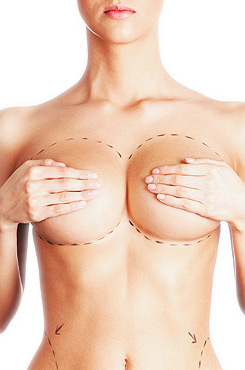
A breast lift, also known as mastopexy, raises the breasts by removing excess skin and tightening the surrounding tissue to reshape and support the new breast contour.
Sometimes the areola becomes enlarged over time, and a breast lift will reduce this as well.
A breast lift can rejuvenate figure with a breast profile that is more youthful and uplifted. A woman's breasts often change over time, losing their youthful shape and firmness. These changes and loss of skin elasticity can result from pregnancy, breastfeeding, weight fluctuations, aging, gravity and/or heredity.
Breast lift surgery does not significantly change the size of breasts or round out the upper part of breast. If you want your breasts to look fuller, consider breast lift and breast augmentation surgery. If you want smaller breasts, consider combining breast lift and breast reduction surgery.
Complications
Potential complications of breast lift surgery may include bleeding or hematoma formation, infection, changes in nipple or breast sensation, which may be temporary or permanent, breast contour and shape irregularities, breast asymmetry, fat necrosis, fluid accumulation and scars.
Breast lift and breast implant placement
Some women may want to consider placement of a breast implant in addition to the breast lift.
An implant can provide improved upper breast fullness or cleavage. Implants can be placed at the same time or as a second procedure, depending on the experience of the surgeon.
The procedure
Breast lift can be achieved through a variety of incision patterns and techniques. The appropriate technique will be determined based on breast size and shape, the size and position of areolas, the degree of breast sagging, skin quality and elasticity as well as the amount of extra skin.
The procedure can be made under intravenous sedation or general anesthesia..
There are three common incision patterns:
- Around the areola
- Around the areola and vertically down from the areola to the breast crease
- Around the areola, vertically down from the breast crease and horizontally along the breast crease
After the incisions the underlying breast tissue is lifted and reshaped to improve breast contour and firmness. The nipple and areola are repositioned to a natural, more youthful height. If necessary, enlarged areolas are reduced by excising skin at the perimeter. Excess breast skin is removed to compensate for a loss of elasticity.
After the breasts are reshaped and excess skin is removed, the remaining skin is tightened as the incisions are closed.
Some incision lines resulting from breast lift are concealed in the natural breast contours; however, others are visible on the breast surface. Incision lines are permanent, but in most cases will fade and significantly improve over time.
Sutures are layered deep within the breast tissue to create and support the newly shaped breasts. Sutures, skin adhesives and/or surgical tape may be used to close the skin.
Recovery
During breast lift recovery, dressings or bandages will be applied to the incisions after the procedure is completed.
You'll need to wear an elastic bandage or support bra to minimize swelling and support your breasts as they heal.
A small, thin tube may be temporarily placed under the skin to drain any excess blood or fluid that may collect.
Medications to apply or take orally to aid healing and reduce the potential for infection.
Resume normal activity and exercise is possible after seven days

